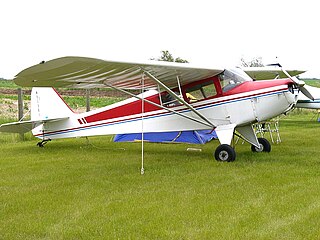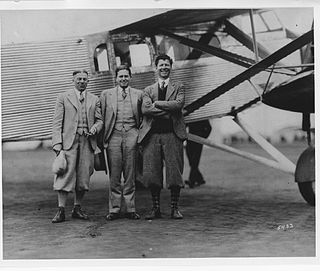Related Research Articles

Iris Louise McPhetridge Thaden was an American aviation pioneer, holder of numerous aviation records, and the first woman to win the Bendix trophy, alongside Blanche Noyes. She was inducted into the Arkansas Aviation Historical Society's Hall of Fame in 1980.

Taylorcraft Aviation is an airplane manufacturer that has been producing aircraft for more than 70 years in several locations.

Avco Corporation is a subsidiary of Textron which operates Textron Systems Corporation and Lycoming.

The Metal Aircraft Flamingo was a monoplane produced in Cincinnati, Ohio by the Metal Aircraft Corporation in the 1930s.

The Culver Dart was a 1930s American two-seat light monoplane aircraft produced by the Dart Aircraft Company.

The Cessna Model CW-6 was a 1920s American six-seat touring aircraft built by the Cessna Aircraft Company.

The Kinner R Playboy was a 1930s American two-seat sporting monoplane built by Kinner Airplane & Motor Corporation.
The Larkin Aircraft Supply Company (Lasco) was an Australian aircraft manufacturer based at Coode Island in Melbourne.

The Harlow PJC-2 was a 1930s American four-seat cabin monoplane, designed by Max Harlow.

International Aircraft Corporation was an American 1920s aircraft manufacturer located in Ancor near Newtown, Ohio.

The International F-18 Air Coach was a 1920s American biplane transport that was designed and manufactured by the International Aircraft Corporation in Long Beach, California. The company stopped manufacturing F-18's by 1928 and sold its rights to the aircraft in 1931.
The Security Airster S-1 is an American two-seat single-engined monoplane designed by Bert Kinner and built by his Security National Aircraft Corporation later named the American Aircraft Corporation.

Stout Metal Airplane Division of the Ford Motor Company was an American aircraft manufacturer founded by William Bushnell Stout as the Stout Metal Airplane Co. in 1922. The company was purchased by Ford Motor Company in 1924 and later produced the Ford Trimotor. At the height of the Great Depression, Ford closed the aircraft design and production division in 1936, temporarily re-entering the aviation market with the production of the B-24, at the Willow Run aircraft factory during World War II.
The Thaden T-1 Argonaut was a 1920s American eight-seat all-metal cabin monoplane, built by the Thaden Metal Aircraft Company of San Francisco, California.

The Thaden T-2 was a 1920s American four-seat all-metal cabin monoplane built by the Thaden Metal Aircraft Company of San Francisco, California.

The Thaden T-4 Argonaut was a 1930s American four-seat all-metal cabin monoplane built by the Thaden Metal Aircraft Company of San Francisco, California.

George Henry Prudden, Jr. was an American aircraft engineer. He was instrumental in designing the first all metal aircraft in America. He was president of the Early Birds of Aviation in 1961.
Metal Aircraft Corporation was an American aircraft manufacturer of transport aircraft. The company was a pioneer in all-metal construction at a time when the technology was in its infancy.

The Lindbergh Boom (1927–1929) is a period of rapid interest in aviation following the awarding of the Orteig Prize to Charles Lindbergh for his 1927 non-stop solo transatlantic flight in the Spirit of St. Louis. The Lindbergh Boom occurred during the interwar period between World War I and World War II, where aviation development was fueled by commercial interests rather than wartime necessity. During this period, dozens of companies were formed to create airlines, and aircraft for a new age in aviation. Many of the fledgling companies funded by stock went under as quick as they started as the stock that capitalized them plummeted in value following the Wall Street Crash of 1929. The Great Depression dried up the market for new aircraft, causing many aircraft companies to go into bankruptcy or get consolidated by larger entities. Air racing, record attempts, and barnstorming remained popular, as aviators tried to recapture the prizes and publicity of Lindbergh's Transatlantic flight.
References
| Wikimedia Commons has media related to Thaden aircraft . |
- Notes
- Bibliography
- The Illustrated Encyclopedia of Aircraft (Part Work 1982–1985). Orbis Publishing.